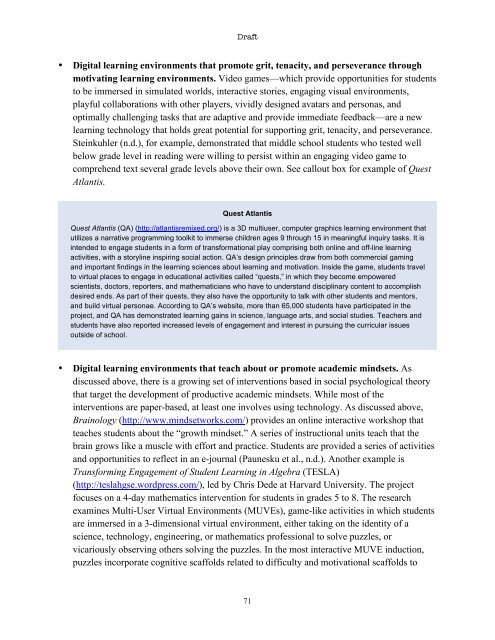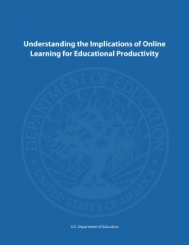Promoting Grit, Tenacity, and Perseverance - U.S. Department of ...
Promoting Grit, Tenacity, and Perseverance - U.S. Department of ...
Promoting Grit, Tenacity, and Perseverance - U.S. Department of ...
Create successful ePaper yourself
Turn your PDF publications into a flip-book with our unique Google optimized e-Paper software.
Draft<br />
• Digital learning environments that promote grit, tenacity, <strong>and</strong> perseverance through<br />
motivating learning environments. Video games—which provide opportunities for students<br />
to be immersed in simulated worlds, interactive stories, engaging visual environments,<br />
playful collaborations with other players, vividly designed avatars <strong>and</strong> personas, <strong>and</strong><br />
optimally challenging tasks that are adaptive <strong>and</strong> provide immediate feedback—are a new<br />
learning technology that holds great potential for supporting grit, tenacity, <strong>and</strong> perseverance.<br />
Steinkuhler (n.d.), for example, demonstrated that middle school students who tested well<br />
below grade level in reading were willing to persist within an engaging video game to<br />
comprehend text several grade levels above their own. See callout box for example <strong>of</strong> Quest<br />
Atlantis.<br />
Quest Atlantis<br />
Quest Atlantis (QA) (http://atlantisremixed.org/) is a 3D multiuser, computer graphics learning environment that<br />
utilizes a narrative programming toolkit to immerse children ages 9 through 15 in meaningful inquiry tasks. It is<br />
intended to engage students in a form <strong>of</strong> transformational play comprising both online <strong>and</strong> <strong>of</strong>f-line learning<br />
activities, with a storyline inspiring social action. QA’s design principles draw from both commercial gaming<br />
<strong>and</strong> important findings in the learning sciences about learning <strong>and</strong> motivation. Inside the game, students travel<br />
to virtual places to engage in educational activities called “quests,” in which they become empowered<br />
scientists, doctors, reporters, <strong>and</strong> mathematicians who have to underst<strong>and</strong> disciplinary content to accomplish<br />
desired ends. As part <strong>of</strong> their quests, they also have the opportunity to talk with other students <strong>and</strong> mentors,<br />
<strong>and</strong> build virtual personae. According to QA’s website, more than 65,000 students have participated in the<br />
project, <strong>and</strong> QA has demonstrated learning gains in science, language arts, <strong>and</strong> social studies. Teachers <strong>and</strong><br />
students have also reported increased levels <strong>of</strong> engagement <strong>and</strong> interest in pursuing the curricular issues<br />
outside <strong>of</strong> school.<br />
• Digital learning environments that teach about or promote academic mindsets. As<br />
discussed above, there is a growing set <strong>of</strong> interventions based in social psychological theory<br />
that target the development <strong>of</strong> productive academic mindsets. While most <strong>of</strong> the<br />
interventions are paper-based, at least one involves using technology. As discussed above,<br />
Brainology (http://www.mindsetworks.com/) provides an online interactive workshop that<br />
teaches students about the “growth mindset.” A series <strong>of</strong> instructional units teach that the<br />
brain grows like a muscle with effort <strong>and</strong> practice. Students are provided a series <strong>of</strong> activities<br />
<strong>and</strong> opportunities to reflect in an e-journal (Paunesku et al., n.d.). Another example is<br />
Transforming Engagement <strong>of</strong> Student Learning in Algebra (TESLA)<br />
(http://teslahgse.wordpress.com/), led by Chris Dede at Harvard University. The project<br />
focuses on a 4-day mathematics intervention for students in grades 5 to 8. The research<br />
examines Multi-User Virtual Environments (MUVEs), game-like activities in which students<br />
are immersed in a 3-dimensional virtual environment, either taking on the identity <strong>of</strong> a<br />
science, technology, engineering, or mathematics pr<strong>of</strong>essional to solve puzzles, or<br />
vicariously observing others solving the puzzles. In the most interactive MUVE induction,<br />
puzzles incorporate cognitive scaffolds related to difficulty <strong>and</strong> motivational scaffolds to<br />
71
















